If you want to see the future, look toward Europe.
On Tuesday, the ban on incandescent light bulbs begins in the EU, the New York Times reports. It’s part of an attempt to limit greenhouse gases but the debate continues over whether the cure is just as bad.
The U.S. is headed toward a similar de facto ban. I wrote about it in the infant days of News Cut. (And here.)
Any substantive conversation about the U.S. ban disappeared when Rep. Michele Bachmann filed a bill to delay implementation, not so much because there aren’t some legitimate concerns about the replacement, but — let’s face it — because it was Michele Bachmann.
But there are some concerns about the CFL bulb, even beyond the mercury content. Stick one in your garage door opener bulb socket sometime. It doesn’t last very long. I tried. Several times. What about the little light bulb in your fridge? Or your oven? Or work lights (Don’t talk to me about those LED work lights; I tested one of those — for $35 — this year and next to the day I got married and the day my children were born, the day I tossed that junk in the trash was the happiest day of my life)? CFL bulbs have improved, but not by a lot. LEDs may be the answer in some applications — autos, traffic signals, Christmas lights — but not a lot of everyday ones.
There maybe be a solution on the way. NPR has the story this evening about a firm that is making a hybrid incandescent bulb that uses less electricity than the the CFL. Expensive? You bet.
But back to the UK for a minute. The government has asked people to keep an eye on shopkeepers who still sell incandescents. Some are said to be importing the “illegal” bulbs from China. And that brings up another likely problem when it disappears from the U.S. scene — the underground bootlegged incandescents. Incandescent speakeasies. Mysterious men in overcoats who whisper, “Psst, buddy. Want to buy a light bulb?”
Which is why I’m stocking up. It could be the answer to my 403B woes.
(Light bulb photo above:

